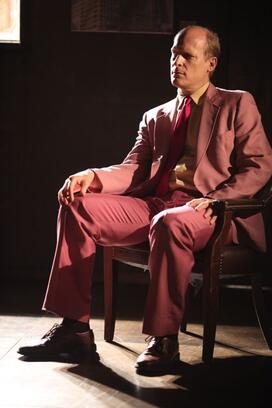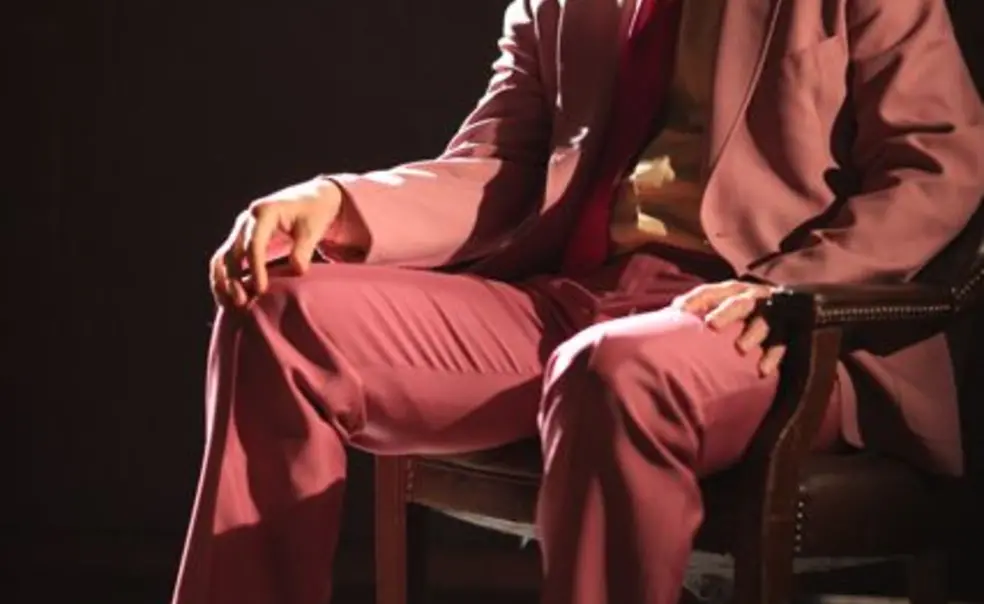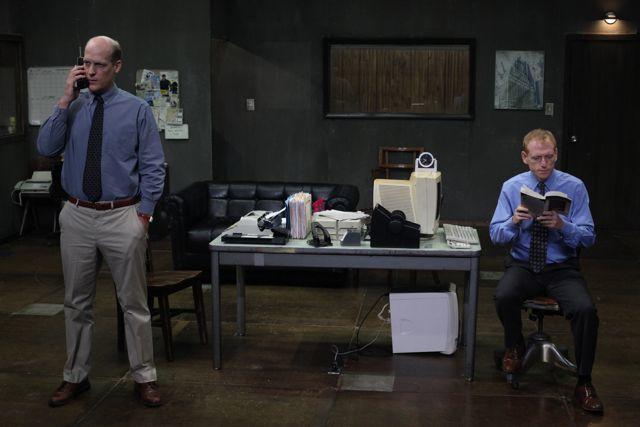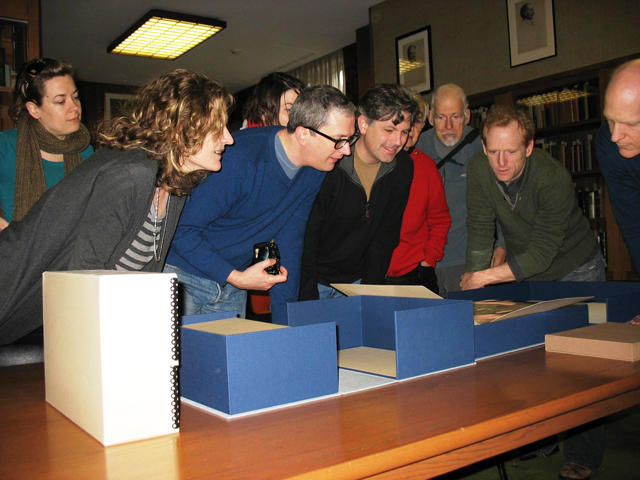Review - Gatsby in full, on stage at McCarter
Cast of 'Gatz' views manuscripts before memorable performances

The lights come up on a dingy office with the sound of a busy avenue just outside. Its sad furnishings are from all decades of the 20th century: a 1950s black leather sofa; 1930s metal desks and chairs; clunky early computers. At far stage right, a dark-haired man crouches over a sound system, sipping coffee. You’ve just noticed him, when the office door opens and a slim, preppy-handsome fellow in a macintosh, blue button-down shirt and suit pants, with freckles and sandy hair, comes in and settles down to what looks from its start like a long, mind-numbing day. He has what must be foul coffee in a classic New York takeout cup. His desk clock is broken, showing always 9:40 (as it should be for a timeless novel). His desktop computer is broken, too; both the keyboard and monitor are eventually taken away, never to return. What’s left for him to do? In silence, he slumps – then takes from an ancient, bulky Rolodex an unmistakable copy of The Great Gatsby. It’s the old familiar Scribner’s paperback, with the original edition dust-jacket painting by Francis Cugat reproduced on the cover in brilliant blues. Gatsby’s not a jazz book, it’s a blues book, from the outside in. You recognize the cover from high school, but this time, you sigh with pleasure as the man settles into his chair, smiles, and begins to share his novel with us, holding it furtively at first so only we, and not his fellow employees, can see. And then we hear the opening words we almost recall: “In my younger and more vulnerable years my father gave me some advice …”
The premise of Gatz, staged over a holiday weekend in December by Elevator Repair Service at the Berlind Theater, is pure and simple: the small cast, headed by a superb Scott Shepherd as Nick Carraway, reads and performs to you aloud every word of F. Scott Fitzgerald ’17’s The Great Gatsby. From the comfortably seductive opening scene, you realize slowly that these people who work in a small, dull office are becoming the characters of the novel. Shepherd, with a flat Midwestern accent masking his natural Southern one, turns seamlessly into Nick, the self-proclaimedly honest, not-quite-omniscient narrator, as he reads. His superior in the office, a taller man with a touch of the elegant roughneck to him, a dazzling smile, and an air of command, must be Jay Gatsby, Jimmy Gatz, the man of mystery. The slim, tan woman in a Lacoste shirt, who strolls in to distribute the mail and then settles onto the couch, becomes Jordan Baker when, with a twist of the wrist, she picks up a copy of Golf Magazine. As the novel and its layered, luminous story begins to spin out, you cannot watch this production in Princeton without thinking about the author, beginning to plan his third and finest novel in the “Middle West” in the summer of 1922.
Fitzgerald, only 25, had rented a house in St. Paul for his young family in late 1921. He, Zelda, and their baby daughter Scottie lived there until summertime, when they decamped to the White Bear Yacht Club in Dellwood, Minn., just northwest of St. Paul. From the lakeshore, he wrote to his editor Max Perkins at Charles Scribner’s Sons about a new novel he was planning: “Its locale will be the middle west and New York of 1885 I think. It will concern less superlative beauties than I run to usually + will be centered on a smaller period of time.” A month later, Fitzgerald had a more intense plan, centering not on plot and characters, but style: “I want to write something new – something extraordinary and beautiful and simple + intricately patterned.” He began Gatsby in earnest in situ, as it were, on the edge of Long Island Sound that fall. Fitzgerald’s setting was New York and the north shore of Long Island, and the time was not 1885, but the summer of 1922, and the immediate aftermath of that summer.
The story, and its characters, are known all over the planet now, after Gatsby’s resurrection by Fitzgerald’s Princeton friend Edmund Wilson ’16 in the 1940s. Daisy’s voice, Jordan Baker’s straight back, Tom Buchanan’s bulk, Meyer Wolfshiem’s nose, Myrtle Wilson’s vitality, Gatsby’s smile: these hallmarks and entirely Modernist-minimal touches of character are not much for a cast of actors to work with. Fitzgerald’s narrative in Gatsby takes over the creation of characters; the dialogue (much of it only reported, later or internally, by Nick) and action is fluid and very difficult to portray. Film after film of Gatsby has failed, from the first one Paramount paid Fitzgerald $50,000 for in 1925, starring Warner Baxter and William Powell, to the already-critically-damned Baz Luhrmann production starring a monolithic-looking Leonardo DiCaprio, an embarrassed-looking Tobey Maguire, and a frail Carey Mulligan looking half DiCaprio’s age as, respectively, Gatsby, Nick, and Daisy. These movies fail because Fitzgerald’s words have already done the cinematic work; there’s little left for a camera, or actor, to do. The novel is concerned with internals, not externals, and is very general about evoking lavish material wealth. Fitzgerald, rather, conjures what he wants to say with only a few strokes of the brush: the sound of a famous, drunken woman singing; a series of damaged expensive cars; a pile of beautiful shirts. We can fill out the pictures for ourselves, but a camera is not equal to the imaginative task.
However, Gatz is a roaring, raging success for exactly the same reason: the words. Fitzgerald’s words, every one of them, realize the characters on stage, making them the characters in his book as well as the everyday folks in a drab gray office. When a pleasant-looking man, tidily dressed, passes down the office’s interior hallway and peers through the window at the desks and people within (and the audience behind them), he says and does nothing else. Yet he has only to be peering through round hornrimmed glasses, as Shepherd reads the words “But above the grey land and the spasms of bleak dust which drift endlessly over it, you perceive, after a moment, the eyes of Doctor T.J. Eckleburg,” and the words and action are united. There is no need in Gatz for a scene change from Gatsby’s house to Nick’s living room, the Buchanans’ mansion, the sad garage, the valley of ashes, the streets of Manhattan: Fitzgerald’s words so easily take us all there.
Gatz started out with improvised reading of parts of Chapters One and Five, in 1999. “A puppet version fell away pretty quickly,” director John Collins smiles as he recalls, and so did a version with the provocative moment of an African-American actor playing Tom Buchanan, bigot and racist. Collins first read Gatsby in 1999, and “completely fell in love with it.” The earliest readings, and stagings, were well received, but felt incomplete to Collins and the company. “We started having to make decisions about when to lose the narration. I couldn’t find anything that felt unnecessary.” So, rather than adapt or truncate the novel, says Collins, “we thought we should force ourselves to do all of it.”
Harold Ober Agency, the longtime representatives of Fitzgerald and of his estate, said no, since a version of Gatsby was in production for the A&E network at the time. Elevator Repair Service would have to wait with their idea until permission was granted. In the interim, ERS turned its literary bent instead to The Last Tycoon, Euripides’ The Bacchae, and Henry James’s Turn of the Screw, wanting the challenge of “doing work almost completely in the dark,” but the company could not stop thinking about Gatsby. They sat and read it aloud, with no staging, and it took five hours. “We could do this,” Collins says. “We were always looking for an impossible task … a problem to solve.” In 2003, he and Scott Shepherd began meeting in Manhattan, in a tiny office space above a garage in SoHo that would inspire the final set. Gatz then came together as a performance well beyond a read-through of the novel, and ERS took the show on the road. Gatz particularly enjoyed some expatriate time in Dublin, where ERS found one of their best and most receptive audiences. Finally, in 2009, they were allowed to go ahead, and Gatz was the runaway success of the off-Broadway year at the Public Theater in 2010.
Up until their time in Princeton, Collins cited the performances of Gatz in Minneapolis as the time when the company felt closest to Fitzgerald. Here, they toured the campus, and met with Don C. Skemer in Firestone Library, where Skemer, the curator of manuscripts, showed them the original cover painting for the book jacket – and Fitzgerald’s final manuscript version of the novel, in his smudgy No. 2 pencil and flowery elegant hand. “Seeing those pages was hugely memorable,” says Collins. “It’s an almost spiritual sensation – you sense you’re in a place that was so important to that novel as you look at them.” He admits, with a laugh, that every time Fitzgerald speaks of Yale or New Haven in the novel, “we secretly replace them with Princeton.”
ERS got its name from a professional-future survey Collins took when he was “about 12.” His future job? “Elevator repairman,” he says, straight-faced. We should all be delighted that he chose to become a theater director instead, and that ERS found its spiritual home for Gatz in the Berlind Theater.
When I was a graduate student at Princeton in the 1990s, I taught Gatsby as a preceptor for Arnold Rampersad, who gave an elegant lecture about the crystalline images Fitzgerald makes with few, short, simple words: “beautiful shirts”; a woman like an “angry diamond”; a woman with her mouth “wide open and ripped at the corners[.]” Words and phrases from the book flooded my head as I left the Berlind Theatre at 10 on a Saturday night – early for Princeton, I thought with a grin. What would the actors do now? Scott Shepherd, who had closed the book – astonishingly – and not opened it again throughout Chapter Nine: How could he stop repeating the last page of Gatsby in his head? As I walked up University Place and looked back at McCarter and the Berlind, still lit up for their evening performances, and for the holidays, I realized that I was literally walking in Fitzgerald’s footsteps: from the old site of 12 University Place, Amory Blaine’s first-year rooms, now partly under the theaters, to 15 University Place, Fitzgerald’s own dorm when he was a freshman. There’s no other place in the world that this could ever happen. Literature sometimes makes magic, and this was one of those times.
Collins was absolutely right to speak of the spiritual experience of seeing Fitzgerald’s last draft of Gatsby. To see the very first draft is an almost indescribable moment. Only two pages of the first draft of Gatsby survive – and these because Fitzgerald sent them, with a letter, to Willa Cather in the spring of 1925. He was worried that his description of a woman he’d initially called Ada was too like that of a character in Cather’s recent A Lost Lady, and didn’t want to be accused of plagiarism. “Now my expression of this was neither so clear, nor so beautiful, not so moving as yours but the essential similarity was undoubtedly there. I was worried because I hated the devil to cut mine out so I went to Ring Lardner and several other people and showed them mine and yours and finally decided to retain it. Also I’ve kept the pages from my first draft to show you and I am enclosing them here.” Cather was not in the least bothered by his description, replying, “So many people have tried to say that same thing before either you or I tried it, and nobody has said it yet…. After all, the only thing one can tell about beauty, is just how hard one was hit by it. Isn’t that so?” Here is Fitzgerald’s first attempt to describe Ada Fay, later Daisy Buchanan’s, now-famous voice: “The sentences were songs. There are no words to describe such voices but there is a promise of gay things in them of something magical done or yet to do.”
These Gatsby pages were given by Charles Scribner III ’73 to Princeton in the late 1970s. Matthew Bruccoli wrote a note for the Princeton University Library Chronicle about them in 1978. Then, until I looked for them the day before I saw Gatz, they had rested quietly in one of the many Fitzgerald correspondence files, behind the letter to Willa Cather they had so long accompanied. It was something far beyond a thrill to hold them, to realize what I was looking at, and to stare at every word, every cross-out, every scribbled change before bringing them carefully up to the desk for a return to their proper, sequestered location.
Princeton is surely where Fitzgerald’s papers belong – his manuscripts and typescripts, his files of scribbled-on newspaper clippings, his apartment keys, souvenir menus from his constant travels, and above all the drafts of his novels. To see, and to use, the library’s treasures is wonderful for an academic, writer, actor, or professional in any field who’s immersed in Fitzgerald. What a perfect place to be while writing about him, and what a perfect place to experience Gatz, in an already-astonishing production that took further inspiration from being here. At the end of Gatz, you’re tired, hushed, disturbed, delighted, and breathtaken, just as you are at the end of re-reading the book. The Great Gatsby has become the great American novel, and its 100th birthday, in April 2025, should be the cause for a huge springtime party here, among the spires and gargoyles.
Anne Margaret Daniel *99 w’86 delivered the keynote address at the F. Scott Fitzgerald Centenary Conference in McCosh Hall in 1996. For more on Fitzgerald’s days at Princeton, watch Daniel’s 2005 Maclean House Lecture.














No responses yet